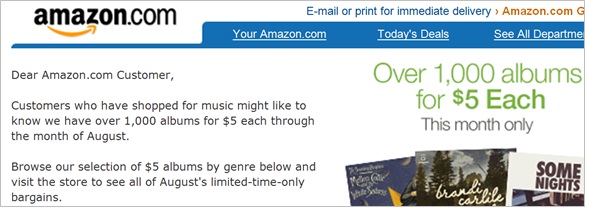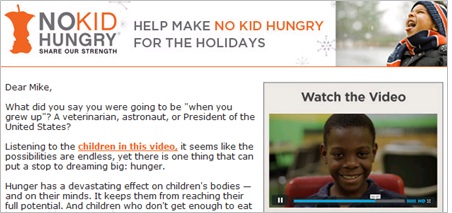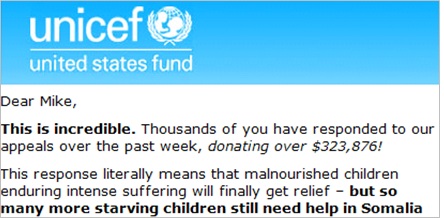This article was originally posted in AFP’s weekly eWire newsletter.
Nonprofits can learn from email campaigns corporate marketers are sending.
Corporate email programs have focused on delivering value—they test offers, messaging and more. They send relevant content based on subscriber interests, preferences and actions.
A 2011 Gleanster survey found their most important value drivers were:
- Testing and measuring everything
- Building in targeting capabilities
As a result, email expectations have changed. Your constituents now expect to receive relevant and interesting information in every email.
Think about what's in your inbox. Daily deals, airfare price alerts, offers from favorite retailers and social media alerts. Add in family and friends and the inbox has become a competitive place.
So, how can your email campaigns stand out? Here are 3 ways:
1. Use Personalized Messaging on Different Audiences
Send something I'm interested in and I'm more likely to read it. I'm then more likely to read your next email. And perhaps your next tweet or mailing.
It's not just me. Delivering personalized content to your audiences can significantly increase click-through rates. It's also been reported as the top tactic to deliver relevant and engaging content.*
While nonprofits often personalize direct mail campaigns—based on giving history, interests and past actions—that approach isn't always carried over to their email campaigns.
How to Personalize Your Emails
During the webinar, I shared several ways to personalize email content. You can insert personalized content that:
- Cultivates (thank recent donors/volunteers; report how gifts were used)
- Provides value (relevant content; event reminders)
- Solicits (matching funding interests)
- Helps data integrity (verify mailing address; find out interests)
#3 is important for appeal campaigns. The more you can include funding opportunities that match someone's interests, the more success you'll have. For example, if you know I’m interested in lung cancer issues, send me a lung cancer project or research to fund.
The Price of "One-Size-Fits-All"
Your constituents will likely only take a few seconds to decide whether to hit "Delete" or keep reading. Personalized content may be what catches their attention, establishes a connection and keeps them reading.
Conversely, if you're not delivering personalized content, your email could negatively impact your relationships. Send too many "one size fits all" emails and you risk lower attention levels and, ultimately, less engaged constituents.
2. Test Subject Lines And Calls to Action, For Starters
MarketingSherpa's gigantic 2011 Email Marketing Benchmark Survey found that, in the corporate world, the most effective email elements to test are:
- Target audience
- Landing page
- Subject line
- Call-to-action link
Should nonprofits follow suit and test these elements?
I've mentioned the importance of targeting the right audience with the right message. Your audience segments, though, may not be large enough to test.
Same thing with your landing pages. Unless you're getting 1,000+ click-throughs to a landing page, the sample size is likely too small.
Subject lines and call-to-action links, however, are ideal elements for nonprofits to test. Especially if you've done minimal testing up until now.
I've worked with many nonprofits that have seen a good jump in clicks and conversions from subject line testing. One tripled their donations last year for a fall appeal. After testing 5 different ones, they finally found one that really resonated with constituents.
You'll also find the more you test subject lines, the more you'll get a feel for what interests your recipients.
Call-to-Action Link Testing
Next, try testing call-to-action links. In case you didn't see, nonprofit click-through rates declined 16% in 2012.**
There are likely many reasons for this. But since your goal is to get people to click-through to the next step, it's a worthwhile test.
Test the link language, placement, image vs. text, or link frequency. You might also test including a video screen shot, which Forrester Research found increases clicks two-three times.
How to Test
To start testing, send one subject line to 10 percent of your list. Send another one to a different 10 percent. Wait one-two days, and then send the winning subject line to everyone else.**
Simple enough? Online tools often do most of the work for you, including automatically and randomly dividing your list.
When looking at test results, make sure you achieved statistical significance. eMarketing Dynamics' free calculator can do this for you.
Note: The 10 percent/10 percent/80 percent example works best for 10,000+ email lists. If your list is under 5,000, increase the ratios to 20 percent/20 percent/60 percent.
3. Follow-Up Approaches
With the average nonprofit open rates at 14%, it's important to send multiple emails in a campaign.*** Your first email may simply go unread. So may your second.
However, it can be hard for nonprofits to decide what to say in follow-up emails. Maybe creating the first email was tough enough. Plus, those emails still need to be useful and interesting to your readers.
One effective follow-up approach is to add a short note above your initial email. It's also efficient, since you only have to write a few lines. Here are four different ways to do it:
1) Related News of the Day
Leverage related news of the day to add urgency and another ask to your campaign. These emails aren't always planned.
2) Progress Update
Update recipients on the campaign's progress and what's been accomplished. It's a great way to grab attention, before making another ask.
3) In Case You Didn't See This
Ever get an email from a co-worker that starts, "In case you didn't see my email…"? It usually gets my attention. Try this approach—just be careful with your tone. Think casual and non-confrontational.
4) Deadline Alert
You've likely seen this in year-end campaigns. It works well the rest of the year, too.
Finally, be sure to monitor your opt-out, open, click-though and conversion rates on follow-up emails. If they significantly worsen, look to use a different approach.
These are just a few pieces within an engaging email campaign. I cover more —mobile, channel integration, messaging, structure—in a recent AFP webinar, which you can watch here.
*MailerMailer's 2010 Email Marketing Metrics Report, 2011 MarketingSherpa Email Marketing Benchmark Survey
**Blackbaud's 2013 Online Marketing Benchmark Study for Nonprofits
***2013 eNonprofit Benchmark Study by NTEN and M+R
Google







No comments:
Post a Comment